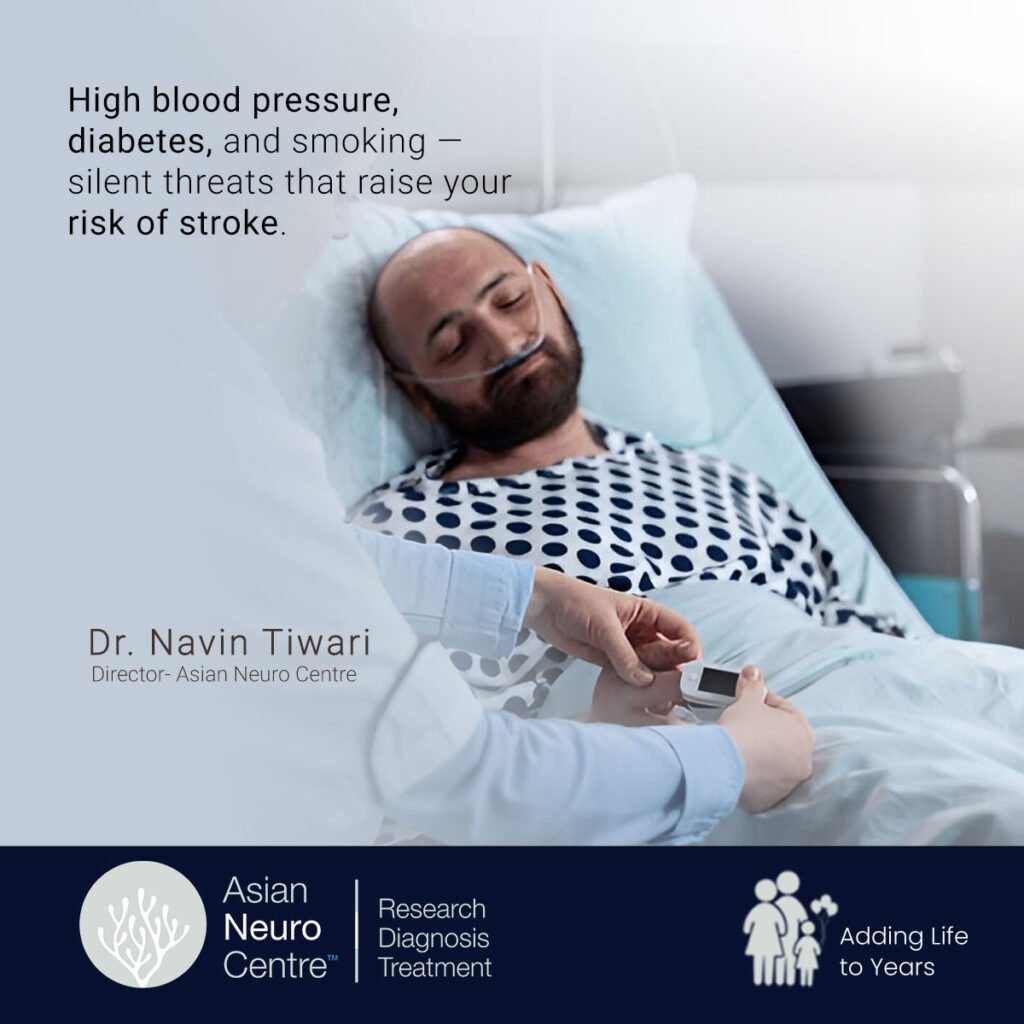- Have any questions?
- 911 12345 29
- info@asianneurocentre.com
What are Stroke Risk Factors?
Can Parkinson’s Disease Turn into Alzheimer’s?
July 31, 2025Is It Possible to Have Alzheimer’s at an Early Age?
August 20, 2025A stroke is a condition requiring medical attention, which happens when oxygen and nutrients to some portions of the brain are blocked or slowed down in their circulation (delivery).
A few minutes later, brain cells start dying. Being able to identify risk factors of stroke is imperative for prevention and early intervention, which can be very effective in improving the results.
Here we delve into the various factors that increase a person’s likelihood of experiencing a stroke.
What is a Stroke?
Stroke can be of two categories:
- Ischemic Stroke: It is the most widespread form, which comprises approximately 87 percent of all strokes. It occurs when there is an obstruction in the blood vessel supplying the brain, usually due to a blood clot.
- Hemorrhagic Stroke: It happens when a blood vessel in the brain leaks or bursts, causing the blood to flow in the tissues of the brain.

Stroke’s Major Risk Factors
Stroke risk factors can be broadly categorized into two groups: modifiable (things you can change) and non-modifiable (things you cannot change).
Non-Modifiable Risk Factors
These are issues that cannot be changed because they are inherent to an individual.
- Age: The risk of stroke rises enormously by the weight of age. Although strokes may ail people at any age, after age 55, the risk is projected to increase rapidly by about a factor of two every 10 years.
- Family History: The presence of a family history of a stroke or heart disease can be a hint of a genetic influence. In case a close relative of yours suffered a stroke, you are more likely to be at risk.
- Gender: Men are at a higher risk of stroke as compared to women, but aging reduces this risk. Women have a greater lifelong stroke risk because of the advantage of longevity, women-specific stroke risk factors such as pregnancy, and some hormonal treatments.
- Race and Ethnicity: There are racial and ethnic groups with an increased occurrence of stroke. To illustrate, African Americans are almost twice as likely as Caucasians to have a first strike, at least partially because of high numbers of high blood pressure, diabetes, and sickle cell anemia.
Changeable Risk Factors
All these are issues that may be controlled or altered by modifying their patterns of living, with medication, or even both. Management of these factors is the critical issue of stroke prevention.
- High Blood Pressure (Hypertension): This is by far the most relevant risk factor of stroke. Over time, its effect on blood vessels is negative as the latter are prone to get narrow or break or develop clots.
- High Cholesterol: High levels of LDL (“bad”) cholesterol contribute to the buildup of plaque in the arteries (atherosclerosis), which can lead to blockages and increase the risk of ischemic stroke.
- Diabetes: Individuals who have diabetes face a far higher risk of stroke. Elevated blood sugar may cause destruction of blood vessels as well as atherosclerosis.
- Heart Disease: Conditions like atrial fibrillation (an irregular heartbeat), heart failure, and heart valve disease can lead to the formation of blood clots in the heart. Once such clots reach the brain, they may give rise to an ischemic stroke.
- Smoking: Smoking causes damage to blood vessels, increases blood pressure, thickens the blood, thus predisposing it to clotting. Active smoking as well as exposure to secondhand smoke considerably raises the risk of a stroke.
- Obesity and Inactivity: Other risk factors that accompany being overweight /obese include high blood pressure, high cholesterol levels, and diabetes. Such risks are also increased by a lack of activity.
- Unhealthy Diet: People with high intake of food containing saturated and trans fats, cholesterol, and sodium would be prone to high blood pressure and atherosclerosis. A healthy diet, namely a diet that is rich in fruits, vegetables, and whole grains, is protective.
- Overuse of Alcohol: Excessive consumption of alcohol may increase blood pressure, cause obesity, and interact with drugs. Moderate consumption might have some protective effects, but this is obviously a risk factor when it is overused.
- Stress: Indirectly, stroke risk may increase due to episodes of stress that result in elevated levels of blood pressure and unhealthy coping behavior, such as smoking and overeating.
Conclusion
Stroke presents a significant cause of death and long term disability around the globe. Although there is no way to control certain risk factors, many are ones that we can control.
These risk factors can be reduced through learning and attending to them, thus greatly minimizing the likelihood of occurrence of a stroke.
Management of diabetes, cholesterol, and blood pressure, maintaining a normal weight, having a balanced diet, keeping fit through physical exercise, and shunning smoking are essential elements in an effective stroke prevention plan.
The understanding of these factors is the first step to prevention, and awareness of them enables one to make decisions that can save one’s life.
Dr. Navin Tiwari
Consulting Neurologist
